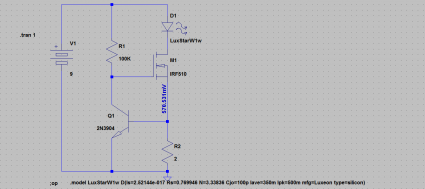I recall burning three or four weeks of a sabbatical getting Saccade.com on the air with Wordpress. So much tweaking…
A simple constant current LED circuit
I’ve been pretty happy with the performance of my linear current based LED transmitter, but that was just sitting on the bench, driving a 20ma device. As I played with the circuit, I began to realize that if I scaled the circuit up to a 1W LED, its deficiencies in terms of efficiency would become more evident. In particular, I began to think about the efficiency: what percentage of the total power delivered by the battery is actually consumed by the LED?
Rather than using my previous op amp circuit, I thought I’d analyze the basic circuit from this Instructable, which I’ve created and reproduced with LTSpice:
I substituted components: I used the every popular 2N3904 and IRF510, and entered a simple model for a 1W Luxeon LED, which has a current drop of around 3.4v. I set it for a 9v supply, just for an example. A quick simulation shows that current through the LED is about 285mA, which combined with the voltage drop means the LED is putting out about 973mw.
But there is also a voltage drop through the MOSFET and through the reference resistor R2. The resistor is easy to calculate: the current through it is the same as the current through the LED (285mA) and the resistance is 2 ohms. The voltage drop is the then .57 volts, and the total power is .57V * 285mA or about 165mw.
So, what’s left? Well, we began with 9v, and we drop 3.4 for the LED, and another .57V for the resistor, let’s say the total drop is 4V. That leaves 5V, and at 285mA or about 1.425 watts. Ouch. The total of non-LED components is about 2.6W, only about 1W of which gets to the LED which nets us about 37% efficiency.
We can do a bit better by lowering the supply voltage: dropping it to six volts lowers the current to around 267mA, but the voltage drop across the MOSFET decreases to just a little over 2V, which drops the power to about 550mw. The net result is the efficiency climbs to about 57%.
Of course now more integrated solutions exist: many of which combine voltage regulation and current limiting in very small packages at high efficiencies. For instance, the LM3407 is a 350mA constant current floating buck switching converter. It can achieve efficiencies of 90% over a wide variety of supply voltages in a very small, inexpensive package. It also appears that you can use it with a PWM input to implement dimmer technology. It seems like a chip like this can be the center of an efficient LED transmitter.
More to think about and play with.

Comment from kenny
Time 7/28/2015 at 2:34 am
IF I WANT TO USE 5V CURRENT FROM MY USB POWER BANK SHUOLD I REDUCE THE R1 TO LOWER VALUE ??? HOW TO CALCULATE PLEASE ADVICE , THANK YOU